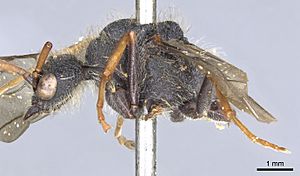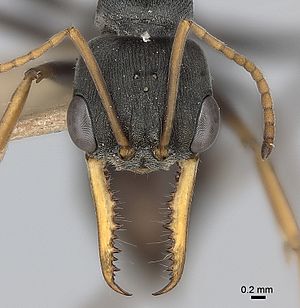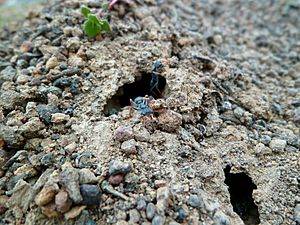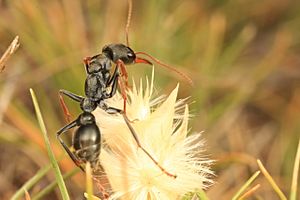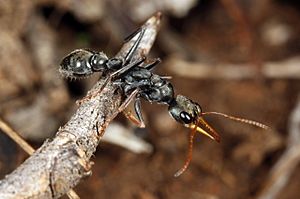Jack jumper ant facts for kids
Quick facts for kids Jack jumper |
|
|---|---|
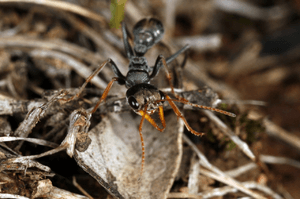 |
|
| Worker ant | |
| Scientific classification | |
| Genus: |
Myrmecia
|
| Species: |
pilosula
|
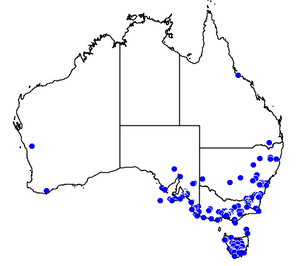 |
|
| Occurrences of the jack jumper ant reported to the Atlas of Living Australia as of May 2015 | |
| Synonyms | |
|
|
The jack jumper ant (Myrmecia pilosula) is a type of venomous ant that lives in Australia. You might also hear it called a jumping jack, hopper ant, or jumper ant. These ants are famous for their amazing ability to jump long distances!
You'll find them mostly in Tasmania and the southeast parts of mainland Australia. They belong to a group of ants called Myrmecia. A British scientist named Frederick Smith first described and named this species in 1858.
Jack jumper ants are quite large. Worker ants and males are usually about 12 to 14 mm (0.5 in) long. The queen ant is even bigger, measuring about 14 to 16 mm (0.6 in). She looks a lot like the workers. Male ants are easy to spot because their jaws are much smaller.
These ants are busy during the day. They live in open areas like bushland, woodlands, and dry forests. They prefer places with gravel and sandy soil, often found in rural areas. You won't see them as much in cities.
Jack jumper ants hunt small insects. They use their special barbless stinger to inject venom and kill their prey. Other ants and various creatures that hunt prey also eat jack jumper ants. A worker ant usually lives for over a year. Interestingly, worker ants can also lay eggs and reproduce with male ants, even if there isn't a queen in the colony.
Their sting usually causes only a small reaction in people. However, it's one of the few ant species that can be dangerous to humans. The venom from their sting can cause serious allergic reactions in some people. About 90% of ant allergies in Australia are caused by this ant's venom. In areas where they live, up to 3% of people are allergic to their venom. About half of these allergic people can have a severe reaction called anaphylaxis. This can cause a fast heart rate, low blood pressure, and other serious symptoms. In rare cases, it can even be deadly. Between 1980 and 2000, four deaths in Tasmania were linked to jack jumper stings. People who have severe allergic reactions can get special treatment to help them.
Contents
What is a Jack Jumper Ant?
The name pilosula comes from a Latin word meaning 'covered with soft hair'. Frederick Smith first identified this ant in 1858. He found specimens of a worker, queen, and male ant in Hobart, Tasmania. The original specimens are kept in the British Museum in London.
The jack jumper ant is known for its unique jumping movement. This is how it got its common names like "jack jumper," "black jumper," "hopper ant," and "jumping jack." Other Myrmecia ants, like M. nigrocincta, also jump. This ant is part of the Myrmecia genus, which is a group of ants in the Myrmeciinae family.
How to Identify a Jack Jumper Ant
Like its relatives, the jack jumper ant has a strong sting and large jaws. These ants can be black or reddish-black. They might also have yellow or orange legs. They are medium-sized compared to other Myrmecia ants. Workers are usually 12 to 14 mm (0.5 in) long. Without their jaws, they are about 10 mm (0.4 in) long.
Their antennae, legs, and jaws are also yellow or orange. They have short, grey hairs on their bodies, especially on their abdomen. Male ants have longer, more abundant grey hairs all over their bodies. The jaws are long and thin, about 4.2 mm (0.17 in) long.
The queen ant looks similar to the workers. However, her middle body is rougher. She is also the largest, measuring 14 to 16 mm (0.6 in) long. Male ants are either smaller or about the same size as workers, around 11 to 12 mm (0.43 to 0.47 in). Males have much smaller, triangle-shaped jaws than workers and queens.
Where Jack Jumper Ants Live and Their Homes
Jack jumper ants are very common in most parts of Australia. You can find them in the southwest of Western Australia, near places like Albany. In South Australia, they are common in the southeast, especially around Mount Lofty. They are found all over Victoria, but are less common in Melbourne. In New South Wales, they are found everywhere except the northwest. They are also widespread in the Australian Capital Territory. In Queensland, they are only found along the southeastern coast. These ants live all over Tasmania.
Jack jumper ants prefer open areas. This includes damp spots, forests, grasslands, gardens, and lawns. They like fine gravel and sandy soil. You can also see their colonies around light bushland. Their favorite natural homes are woodlands, dry open forests, and rural areas. They are not as common in cities.
Their nests are mounds made of fine gravel, soil, and small stones. These mounds can be 20 to 60 cm (8 to 24 in) wide and up to 0.5 m (20 in) tall. Some nests are simple with a shaft inside. Others are complex structures surrounded by a mound. These ants use the sun's warmth to heat their nests. They decorate their nests with seeds, soil, charcoal, stones, sticks, and even small dead insects. They also hide their nests by covering them with leaves, debris, and long grass. Nests can be found under rocks, where queens often start their colonies.
In Tasmania, there are many jack jumper ants in the higher mountain regions. They prefer rural areas with warm, dry, open eucalypt woodlands. This climate gives them warmth and food like nectar and other small creatures. In suburban areas, they build nests in rockeries, cracks in concrete walls, dry soil, and grass.
People can control jack jumper ant populations around homes. Chemicals like bendiocarb and chlorpyrifos work well against them. Pouring carbon disulfide into nest holes and covering them with soil is another way to remove colonies.
How Jack Jumper Ants Behave and What They Eat
Jack jumper ants are mostly active during the day. Workers look for food from morning until evening. They are active in warmer months but sleep during winter. They are known for being aggressive towards humans. They are attracted to movement and have excellent eyesight. They can watch and follow people from 1 meter (3 feet) away!
These ants are amazing jumpers. They can leap 2 to 3 inches (5 to 7.6 cm). One scientist compared them to "Lilliputian cavalry galloping to battle" because of their jumping. He also said they look funny as they come out of their nests in short hops.
What Do Jack Jumper Ants Eat?
Unlike many ants that use smell to find food, jack jumpers use their sight. They move their heads and bodies quickly to focus on their prey with their large eyes. Like other bull ants, they hunt alone. Only worker ants do this job.
These ants eat both plants and animals, so they are omnivores. They also eat dead things they find. They deliver painful stings that help them kill prey and scare off predators. Jack jumpers have smooth stingers, so they can sting many times without losing their stinger.
They are very good hunters because of their excellent vision. They can even kill and eat wasps and bees. They also eat other ants, like carpenter ants. They enjoy sweet plant liquids and other sugary solutions. They often hunt spiders and other small insects and creatures. Jack jumper ants will run and jump at flies when they land on plants. They also hunt cockroaches and crickets.
Adult ants mostly eat sweet things. They give the dead insects they find to their larvae (baby ants). Workers collect small insects and honeydew (a sweet liquid from sap-sucking insects) to feed their young in the nest.
Who Eats Jack Jumper Ants?
Blindsnakes are known to eat Myrmecia ant babies. However, smaller blindsnakes avoid them because they can be stung. Other creatures like assassin bugs and redback spiders also eat jack jumper ants. Echidnas, especially the short-beaked echidna, hunt jack jumper ants and eat their larvae and eggs.
A type of parasite called gregarines can live inside jack jumper ants. Ants with this parasite change color from black to brown. This happens because the parasite stops the ant's skin from darkening properly when it's a pupa.
Life Cycle and Reproduction
Life Cycle of a Jack Jumper Ant
Like all ants, a jack jumper ant starts as an egg. If the egg is fertilized, it will become a female ant. If not, it will become a male ant. They go through complete metamorphosis. This means they have larval and pupal stages before becoming an adult ant.
Cocoons that are separated from the colony can shed their pupal skin on their own. This allows them to become fully colored. Pupae can also emerge from their pupal stage without help from other ants. Once born, jack jumper ants can quickly learn different tasks.
Worker ants live for about 1.3 years on average. Some live as little as 1.12 years or as long as 1.6 years. The queen ant lives much longer, often 10 years or more. Jack jumper ant eggs often stick together in clumps. These clumps can have two to 30 eggs and are carried by worker ants.
Reproduction of Jack Jumper Ants
Queen ants can mate more than once. They usually mate with one to nine males during a special nuptial flight. Most queen ants mate with only one or two males.
Jack jumper ant colonies can have many queens. Usually, one to four queens live in a colony. In colonies with multiple queens, the egg-laying queens are not related to each other. Studies show that having multiple queens is common in jack jumper colonies.
When a queen starts a new nest after mating, she hunts for food to feed her young. This means she is "semiclaustral." Nests can have as few as 500 ants or as many as 800 to 1,000. Worker ants can also reproduce in colonies, whether a queen is present or not.
Jack Jumper Ant Stings: What to Know
The problem with jack jumper stings is different in various areas. Fewer people have allergies in cities, but many more do in rural areas. These ants are a danger to people in southern Australia because many people are very allergic to their sting. The ant is a major cause of serious insect allergies in Australia. In fact, it causes more cases of anaphylaxis than honeybee stings. Over 90% of ant venom allergies in Australia are caused by the jack jumper.
The ant is well-known in Tasmania, where most deaths from stings have happened. In 2005, over a quarter of all jack jumper sting incidents were in Tasmania, even though it has a small population. Jack jumper stings are the most common cause of anaphylaxis at the Royal Hobart Hospital. The ant also causes many anaphylaxis cases outside Tasmania, especially around Adelaide and Melbourne. About 1 in 50 adults have had anaphylaxis from a jack jumper or other Myrmecia ant sting.
Signs and Symptoms of a Sting
Reactions to jack jumper stings are similar to fire ant stings. You might see local swelling that lasts for several days. Your lips, face, and eyes might swell from a minor allergic reaction. Other common symptoms include watery eyes and nose. You might also get hives or welts. Headaches, anxiety, and flushing can also happen.
People usually feel a sharp pain after these stings, like an electric shock. Some people get a skin reaction all over their body. Every sting causes some local reaction. But severe reactions only happen if someone is stung many times (50 to 300 stings for adults). Your heart rate can increase, and blood pressure can drop quickly. Most people will only have mild skin irritation after being stung.
Most people recover well after a mild local reaction. About 3% of people have a severe local reaction. If you have a severe local reaction, you are likely to have another if stung again. Deaths are rare, and special venom treatment can prevent them.
First Aid for a Jack Jumper Ant Sting
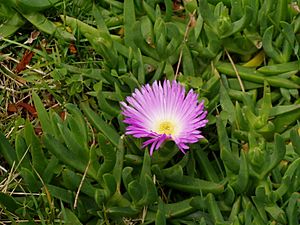
If there are no signs of an allergic reaction, you can use an ice pack or special sprays to ease the pain. Washing the stung area with soap and water is also recommended. If the pain lasts for several days, you can take antihistamine tablets.
If someone has a severe allergic reaction, they need emergency treatment. Lay the person down and raise their legs. They might be given an EpiPen or an Anapen to use if they get stung. If they have anaphylaxis, they might need more adrenaline and other medicines. Some people with severe anaphylaxis might have a cardiac arrest and need resuscitation. If someone has asthma and reacts to a sting, they might use an inhaler.
There are also some bush remedies for jack jumper stings. The young tips of a bracken fern can be rubbed on the stung area. This might help relieve the local pain. Another plant used as a bush remedy is Carpobrotus glaucescens.
Images for kids
-
The Royal Hobart Hospital in Hobart, Tasmania offers a special program for people who are very allergic to jack jumper ant stings.
See also
 In Spanish: Myrmecia pilosula para niños
In Spanish: Myrmecia pilosula para niños


